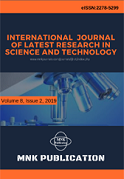DOI:10.29111/ijlrst ISRA Impact Factor:3.35, Peer-reviewed, Open-access Journal
Research Paper Open Access
International Journal of Latest Research in Science and Technology Vol.6 Issue 6, pp 9-11,Year 2017
Correspondence should be addressed to :
Received : 10 November 2017; Accepted : 20 December 2017 ; Published : 31 December 2017

| Download | 125 |
|---|---|
| View | 179 |
| Article No. | 10764 |
This paper encapsulate the continuous explores about the trial research on the utilization of bagasse ash in the development of low volume traffic roads. The primary concentration of this research was to enhance the vehicle business in order to bring about more prominent economy and versatility of products and ventures by creating monetary roads and furthermore to use the different agro-wastes in the development business to bring about appropriate waste administration for natural defencelessness and eco-protection. for this situation sugarcane bagasse ash(an agro-squander) is being used for the Construction of low volume traffic roads(village roads, city road roads and other blood vessel roads).
Copyright © 2017 Er. Amit Spehia et al. This is an open access article distributed under the Creative Commons Attribution 4.0 International (CC BY 4.0) license which permits unrestricted use, distribution, and reproduction in any medium, provided the original work is properly cited.
Er. Amit Spehia , Er. Kshipra Kapoor , Narinder Singh , " Construction Of Low Volume Traffic Roads With The Use Of Bagasse Ash- A Review ", International Journal of Latest Research in Science and Technology . Vol. 6, Issue 6, pp 9-11 , 2017

MNK Publication was founded in 2012 to upholder revolutionary ideas that would advance the research and practice of business and management. Today, we comply with to advance fresh thinking in latest scientific fields where we think we can make a real difference and growth now also including medical and social care, education,management and engineering.

We offers several opportunities for partnership and tie-up with individual, corporate and organizational level. We are working on the open access platform. Editors, authors, readers, librarians and conference organizer can work together. We are giving open opportunities to all. Our team is always willing to work and collaborate to promote open access publication.

Our Journals provide one of the strongest International open access platform for research communities. Our conference proceeding services provide conference organizers a privileged platform for publishing extended conference papers as journal publications. It is deliberated to disseminate scientific research and to establish long term International collaborations and partnerships with academic communities and conference organizers.